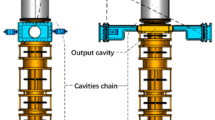Abstract
The damage that occurs at alumina windows of high-power millimeter wave gyrotrons operating in TE0,n mode is investigated. This damage appears only on the air side of the window where it yields small spot-like features (diameter <1 mm) and circular "melting" patterns (diameter >1 cm). The damage observed is thought to be related to rf field enhancements by resonances of trapped electromagnetic modes and by protrusions and contaminations of the ceramic surface.
Similar content being viewed by others
References
Nickel, H.-U., Heidinger, R., 1992, A survey of vacuum-windows for high-energy millimeter-wave systems in fusion experiments, 20th Symp. on Electromagnetic Windows, Atlanta, Georgia, Proceedings, 62–71.
Nickel, H.-U., Halbritter, J., 1991, Surface melting at ceramic windows due to high-power millimeter waves, 16th Int. Conf. on Infrared and Millimeter Waves, Lausanne, Switzerland, Conference Digest, SPIE Vol. 1576, 456–457.
Borie, E., Gantenbein, G., Jödicke, B., Dammertz, G., Dumbrajs, O., Geist, T., Hochschild, G., Kuntze, M., Nickel, H.-U., Piosczyk, B., Thumm, M., 1992, Mode competition using TE03 gyrotron cavities,Int. J. of Electronics,72, 687–720, the damage occurred at the gyrotron here referred to as the prototype tube. A detailed description of the window is given in Bachmor, R., 1989, Entwicklung der technologischen Grundlagen eines hochbelastbaren Auskoppelfensters für ein 200 kW Langpulsgyrotron bei 140 GHz, ITG-Fachtagung für Vakuumelektronik und Displays, Garmisch-Partenkirchen, Germany, ITG-Fachbericht 108, 203–207.
Behm, K., 1986, Hochleistungs-Gyrotrons für 70 GHz, NTG-Fachtagung für Elektronenröhren und Vakuumelektronik, Garmisch-Partenkirchen, Germany, NTG-Fachbericht 95, 63–68
Bachmor, R., 1990, private communication.
Pochelon, A. Goodman, T., Whaley, D., Tran, M.Q., Perrenoud, A., Reinhard, D., Jödicke, B., Mathews, H.-G., Kasparek, W., Thumm, M., 1990, 39 GHz ECRH system for breakdown studies on the TCA Tokamak, 16th Symposium on Fusion Technology, London, United Kingdom, Proceedings, 1075–1079
Mathews, H.-G., 1991, private communication.
Kasparek, W., Kumrić, H., Müller, G.A., Schüller, P.G., Erckmann, V., 1991, Beam waveguide transmission line for the 140 GHz ECRH system at the stellarator W7-AS, International School of Plasma Physics, Course and Workshop on High Power Microwave Generation and Applications, Villa Monastero, Varenna, Italy, Proceedings, Vol. ISPP-10, 519–524.
Kasparek, W., Müller, G.A., Schüller, P.G., Thumm, M., Wilhelm, R., Erckmann, V., 1986, The 70 GHz/1 MW long-pulse ECRH system on the advanced stellarator W VII-AS, 14th Symposium on Fusion Technology, Avignon, France, Proceedings, 829–834
Kasparek, W., Kumrić, H., Müller, G.A., Schüller, P.G., Thumm, M., Erckmann, V., 1988, Microwave technology and tests of the 70 GHz/1 MW long-pulse ECRH system on the advanced stellarator W VII-AS, 15th Symposium on Fusion Technology, Utrecht, The Netherlands, Proceedings, 490–494.
Landau, L.D., Lifschitz, E.M., 1967,Lehrbuch der Theoretischen Physik, Band 8, Berlin: Akademie Verlag, p. 299.
Heidinger, R., 1993, private communication.
Halbritter, J., 1985, On contamination of electrode surfaces and electric field limitations,IEEE Trans. on Electrical Insulation,20, 671–681
Halbritter, J., 1986, Dynamical enhanced electron emission and discharges at contaminated surfaces,Applied Physics A,39, 49–57.
Halbritter, J., 1972, Electron loading of superconducting rf cavities,Particle Accelerators,3, 163–174.
Saito, Y., Michizono, S., Anami, S., Kobayashi, S., 1992, Surface flashover on alumina rf windows for high-power use, 15th Int. Symp. on Discharges and Electrical Insulation in Vacuum, Darmstadt, Germany, Proceedings, 227–231
Saito, Y., Matuda, N., Anami, S., Kinbara, A., Horikoshi, G., Tanaka, J., 1989, Breakdown of alumina rf windows,IEEE Trans. on Electrical Insulation,24, 1029–1032.
Schwirzke, F., 1991, Vacuum breakdown on metal surfaces,IEEE Trans. on Plasma Science,19, 690–696
Schwirzke, F., Hallal, M.P., Maruyama, X.K., 1992, Ion formation on the surfaces of electrodes,Nuclear Instr. and Methods in Physics Research B,67, 554–559.
Kark, K.W., 1987, Theoretische Untersuchung der Ausbreitung elektromagnetischer Wellen in schwach inhomogenen Hohlleitern, Research Report DFVLR-FB 87–23, Institut für Hochfrequenztechnik der DFVLR, Oberpfaffenhofen, Germany, 37–38.
Quine, J.P., 1968, Oversize tubular metallic waveguides, in Okress, E.C. (Ed.),Microwave power engineering, Vol. 1, New York: Academic Press, pp. 178–213.
Nazaré, S., 1993, private communication.
Author information
Authors and Affiliations
Rights and permissions
About this article
Cite this article
Nickel, HU., Halbritter, J. Damage and erosion at ceramic Windows due to high-power millimeter waves. Int J Infrared Milli Waves 15, 651–664 (1994). https://doi.org/10.1007/BF02096481
Received:
Issue Date:
DOI: https://doi.org/10.1007/BF02096481




